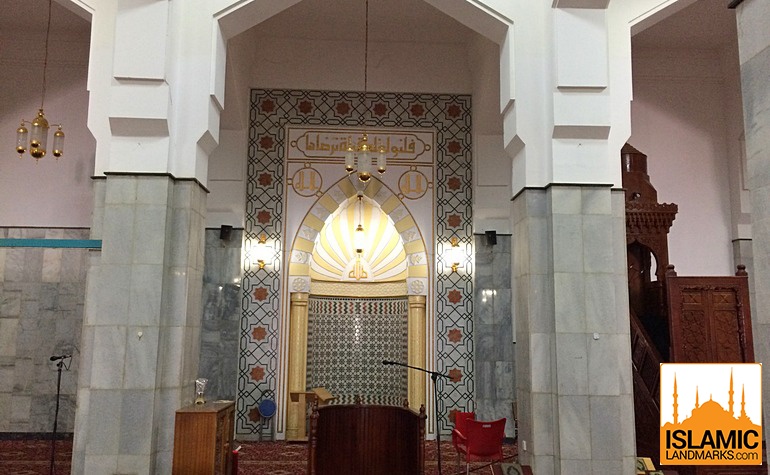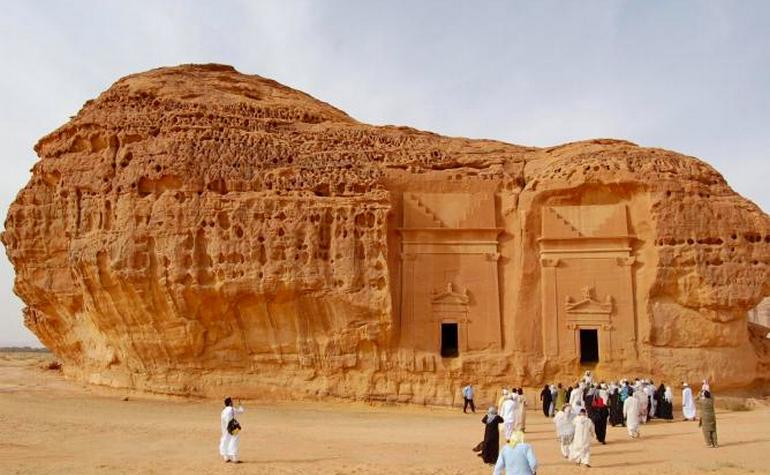Saudi Arabia Islamic History: Site of the Battle of Badr
Badr Battle Site

This picture depicts Badr, where the first battle in Islam took place in Ramadan 2АH. The Prophet (ﷺ) and Sahabah, only 313 the number defeated the Quraish army of 1000 through the help of Allah (ﷻ).
Recommendations: Wikipedia
Hudaybiah

This masid marks the place where the Hudaybi treaty between Muslims and Quraysh in 6 AH was concluded.
Tomb of Bibi Aminah (may Allah be pleased with her)

This tomb, located in Abwa, near Medina, Bibi Amin (may Allah be pleased with her), the mother of the Prophet (ﷺ). She died on her way back from Medina to Mecca when the Prophet (ﷺ) was only six years old.
Video below of Sheikh Tariq Jameel describing the death of the Prophet’s mother:
House of Halemah (may Allah be pleased with her)

These ruins are what remained of Haleem Sa’diya’s house in the Banu Sa’d region in the Hudaybiyah desert. Haleemah (may Allah be pleased with her) raised the Prophet (ﷺ) here in the first years of his life.
Among the inhabitants of Mecca, it was customary to force their newborns to take care of Bedouin women who will grow them in the desert for several years. Makkan’s believed that the untouched, harsh desert atmosphere would make their children strong and resilient. In addition, education among the Bedouins ensures that children learn the purest form of Arabic, which is spoken in all of Arabia.
Abdul Muttalib was looking for one of these Bedouin women who would serve as a nurse and take his grandson to the desert. Some women from Banu Sa’d came to Mecca to offer their services to local families. Abdul Muttalib asked each of them to take their grandson Muhammad, but they all turned down the offer when they were told that the father of the child was dead. They felt that a family without a father would not be able to reward them handsomely.
That day Haleem bint Abu Dhuweb arrived in Mecca. While all the other Bedouin women found children to breastfeed, she had no luck. She saw Abdul Muttalib with a baby in her arms and took pity on a child who was rejected by other women. She and her husband returned the baby Muhammad to the desert, happy that they will not return empty-handed. Halema and her husband, Harith bin Abdul Uza, both belonged to the Sa’d bin Bakr bin Hawazen tribe. Their children became the adoptive brothers and sisters of the Prophet. Their names were Abdullah, Anis and Judham, who were better known as Shayma.
Halemah and her husband discovered that their lives had changed at the very moment when they took Muhammad home. They went to Mecca on a fragile female donkey, who could barely keep up with his caravan. However, on the way back, when Haleem rode with the baby in his arms, the same animal moved so quickly that it left the caravan.
As Muhammad stayed with the Halemah family, the house was filled with blessings. Haleemah herself said that she had brought Muhammad to her home during a drought. Her camel did not give a drop of milk, and her own child cried all night from hunger. With such an upset child, Halemah and Harit have a hard time sleeping at night.
However, everything changed when Halemah brought Muhammad home and put him on his knees. Her breasts are full of milk, so Muhammad and her own child drank milk and slept soundly. When Harith went to the camel, he was amazed at what he saw. Udder camel wool was full of milk and was ready to overflow. He gave so much milk that the Halemam family could sleep that night on full stomachs. It seems that Haleem’s household was untouched by drought, although they lived in Dyara Banu Sa’d, the most arid place in the region. The goats of the family will return from the pasture with their stomachs full of grass, and their udder will be torn by milk. The husband and wife often milked their goats, while others lacked even a drop of milk.
The Halemah family continued to be blessed for the next two years, after which it weaned Muhammad. Although he grew up during a big drought, he turned into a strong, healthy baby.
Every six months, Halemah takes Muhammad to Mecca to be with his mother and other family members. She will then return with him to Dayar Banu Sa’d. After Muhammad was weaned, it was time for him to return to his family forever. When Halema brought him back to her mother, she asked Amina to let her keep the boy longer, because he brought her good luck. She pleaded for him to become stronger and healthier in the desert, far from the frequent epidemics that were raging in Mecca. Amina agreed, and Haleem returned home with Muhammad, pleased with his great happiness.
Two years later, however, a strange event occurred that startled Halemah and her husband, prompting them to return Muhammad to his family in Mecca. Anas bin Malik (may Allah be pleased with him) says that one day, when Muhammad was playing with children near the house of Khalema, Jibril appeared (he had peace) and forced Muhammad to lie down. Then he opened the boy’s chest, pulled out a heart and took a piece of meat out of it, saying, “This is part of Satan in you.” Then he put the heart of Muhammad in a golden tray filled with water from Zamzam, he washed and replaced it in his chest. Other children ran into Halemah in horror, shouting that Muhammad had been killed. When they reached Muhammad, they found him alive, his face turned pale from shock. Anas (may Allah be pleased with him) later said that he had seen a scar on the chest of the Prophet, where he was sewn together.
Following this supernatural event, Muhammad was returned to Mecca, where he grew up over the next two years under the care of his mother.
Halemah (may Allah be pleased with her) died in the year 8AH and was buried in Janatul-Baki in Medina.
Recommendations: When the Moon Split – Sheikh Safiur-Rahman Mubarakpuri
Khaybar

Khaybar is located about 150 km north-west of Medina and is inhabited by a tribe of Jews who instigated hostilities to Muslims. The Prophet (ﷺ), together with 1,400 companions, organized an expedition and conquered the territory in Muharram 7 AH.
Masjid Abdullah bin Abbas (may Allah be pleased with him)

Masjid Abdullah bin Abbas (may Allah be pleased with him)
This masjid (mosque) in Taif is located not far from the tomb of Abdullah bin Abbas (may Allah be pleased with him), the cousin of the Father of the Prophet (ﷺ). He is revered by Muslims for his knowledge and is an expert in Tafsir (exegesis of the Quran), as well as authority over Islamic Sunnah (the practice of the Prophet (ﷺ).
Abdullah bin Abbas (may Allah be pleased with him) was the son of Abbas (may Allah be pleased with him), the father-uncle of the Prophet (ﷺ). His mother was Umm al-Fadl, Maymuna’s sister (may Allah be pleased with her) [one of the Prophet’s wives (ﷺ)]. He was born about three years before the Hijri. When he was born, his mother took him to the Prophet (ﷺ) before he began to suck. The Prophet (ﷺ) put part of his saliva on the tongue of the newborn, and this was the beginning of a close relationship between them.

While he was growing up, he was on the side of the Prophet (ﷺ), performing various services, such as taking water for ablution. He prays with the Prophet (ﷺ) and joins his meetings, journeys, and expeditions. The Prophet (ﷺ) approached him, patted him on the shoulder and prayed: “O Lord, make him a deep understanding of the religion of Islam and instruct him on the meaning and interpretation of the deeds”. Ibn Abbas (may Allah be pleased with him) said: “The Messenger of Allah wiped my chest and said:” Lord, give him wisdom. ” Ibn Abbas (may Allah be pleased with him) dedicated his life to the pursuit of learning and knowledge by following the Prophet (ﷺ) and memorizing his teachings.
Sa’ad ibn Abi Wakkas (may Allah be pleased with him) said: “I have never seen a man who quickly understood who had more knowledge and more wisdom than Ibn Abbas. I saw how Umar invited him to discuss difficult problems in the presence of veterans Badr from among the Mukhadzhireyev and Ansar. Ibn Abbas said, and Umar would not ignore what he had to say.
Abdullah bin Abbas (may Allah be pleased with him) says: “After the departure of the Prophet (ﷺ), I told my friend Ansari. The Prophet (ﷺ) is no longer with us. But a large number of sahaba (satellites of the Prophet) is still among us. Let’s go to them and learn about Islamic practice. ” He said. “Who will approach you to learn the rules in the presence of these distinguished Sahababs?” I was not discouraged. I continued to seek knowledge and approached every person who was supposed to hear something from the Prophet (ﷺ). I managed to gather essential information from the Ansara. If I visited someone from the Sahaba, I found him asleep, I parted the shawl at the gate and sat down.
Sometimes my face and body were covered with dust, but I sat until they woke up and I was able to contact them. Some of them said: “Abdullah, you are the cousin of the Prophet (ﷺ); You could send for us. Why did you take care to come to our places? “I told them:” I have to come to you, because I am a student, and you are my teachers. ” Some people for whom I waited said: “Since when will you be waiting for us? I told them that I was sitting there for quite a while. They said: “What a pity! You could wake us from sleep. I said, “I didn’t like to bother you for my sake.” Thus, I continued my studies until the time came when people began to flock to me to learn. My friend Ansari understood this at the time and noticed. “This boy undoubtedly turned out to be more reasonable than we are.”

Wahab bin Munabah says: “Abdullah bin Abbas (may Allah be pleased with him) lost sight in old age. Once I brought him to Haram in Mecca, where he heard a group of people exchanging hot words between themselves. He asked me to bring him to them. He welcomed them to Assalam Alakim. They asked him to sit down, but he refused and said: “Can I tell you about people whom Allah highly values? These are those whom His fear has brought to absolute silence, although they are neither helpless nor stupid. Rather, they possess eloquence and have the right to speak and understand. But the constant glorification of the name of Allah was so overzealous that their hearts were full and their lips were sealed. When they are established in this state, they rush towards righteousness. Where did you deviate from this course? After this admonition, I never saw the congregation of even two people in Haram. ”
READ MORE: Did Jesus Predict Muhammad? A Biblical Portal Between Christianity and Islam
It was a dedication to the knowledge that made Abdullah bin Abbas (may Allah be pleased with him) so that he would be known as “Hib-ul-Ummat” (the most educated man of Islam) and “Bahrul Ulum” (ocean of knowledge) in his time. He transmitted 1660 Hadith and is generally considered the most famous of the companions in Tafsir. He died in 68 in Taif and is buried in the above masid. Muhammad bin Ali (may Allah be pleased with him) led the funeral and remarked: “Today we have lost our pious leader.”
Source: Fazail-e-Aamal – Sheik Zakariyya Kandhalvi, Journey to the Sacred – Sheik Hamza Yusuf, Wikipedia
Tomb of Maymoonah (may Allah be pleased with her)

This structure is located on the Hijra road, 20 km from Mecca and contains the tomb of maymunah (may Allah be pleased with her), one of the wives of the Prophet Muhammad (ﷺ). It is in Sarif and is the same place where they were married in 7 AH.
READ MORE: 10 Guidelines for Gender Relations in Islam
Maymoonah (may Allah be pleased with her) was the daughter of Harith-bin-Hazan. Her original name was Barra, but she was later renamed the Maymoonah by Prophet Muhammad(ﷺ). She first married Aburema bin Abduluzza. According to some reports, she was married twice before becoming Ummumomininin (mother of believers). She was recently widowed when the Prophet (ﷺ) married her in Sarif, a place lying on the way to Mecca, when he was on his way to “Umrah in Zil-Kad”, 7 A.Kh.
READ MORE: The Role Of Angels In Islam
The Prophet (ﷺ) intended to start living with her when in Mecca after committing “Umrah”, but since Kureish did not allow him to enter Mecca, he called her to him in the same place on the way back. Many years later, the maymunah (may Allah be pleased with her) died and was buried at the exact same place in 51 AD. (at the age of 81). It is a strange coincidence that in a certain place on one trip she is married, in the same place on the way back she begins to live with the Prophet (ﷺ), and in the same place on another trip she dies and is buried there.
Aisha (may Allah be pleased with her) says: “Maymunah was the most pious and most attentive of her kin and kith among the wives of the Prophet.”
Yazid-bin-Asam says: “She was seen or engaged in salat or homework. When she didn’t do either, she was busy in Miswak.
She was the last woman to be married to the Prophet (ﷺ). However, some Muhadditin mentioned one or two other marriages entered into by the Prophet (ﷺ) after her.
References: Fazail-e-Amal – Shake Zakariy Kandhalvi
Masjid Jirranah

Masjid Jirranah is located about 24 km north-east of Masjid Haram and is one of the places where pilgrims enter Ihram state for Umra’s speech. In the year 8A, the Prophet (peace and blessings of Allaah be upon him) settled here for several days after the battle of Hunayn and entered the state of Ihram, and then went to Mecca.
Mada’in Saleh

Madain Saleh (Saleh City) is a pre-Islamic archaeological site located in the Al-Ula sector, about 400 km north-west of the Medina. It is here that the Tamud tribe lives, renowned for its ability to carve houses in the mountains. The Prophet Saleh (peace be upon him) was sent by Allah (ﷻ) to guide them, but they rejected his teachings and were destroyed by an earthquake.
Tomb of Hawa (peace be upon her)

This is the entrance to Jeddah in what is considered the tomb of Hawa (peace be upon her), also known as Eve, the first woman created and Adam’s wife (it will have peace). The name Jeddah means “the ancestors of women.”



![[PHOTOS] Hijrah 1447: Sacred Ceremony of Kaabah’s New Cover Unfolds in Mecca [PHOTOS] Hijrah 1447 - Sacred Ceremony of Kaabah’s New Cover Unfolds in Mecca](https://islamreligionguardian.com/storage/2025/06/PHOTOS-Hijrah-1447-Sacred-Ceremony-of-Kaabahs-New-Cover-Unfolds-in-Mecca-2-218x150.jpg)

